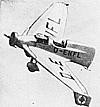The Delta IVc - DFS 39
Test flights of the Delta IVb revealed that the longitudinal stability in respect to the effectiveness
of rudder control was too great, so for the Delta IVc both wings were rotated forward to obtain a sweepback of 23o, versus 30o for the b variant. The test flights also showed that
there was insufficient directional stability, so the rear part of the fuselage was widened and a small rudder added to the vertical end of the fuselage. Small winglets were added to correct
uneven airflow on the fuselage from the propeller. The Delta IVb was given the official RLM designation DFS 39 in 1936 after completing intensive testing at the Federal Flight Testing
Center at Rechlin, and was licensed as as a two-seater sport aircraft.
Powered by a 100 hp piston engine, the DFS 39 had a slightly gulfed delta wing with pronounced wingtip anhedral. At this point the RLM was looking forward to a second version of the DFS 39 powered by an 88 1b (40 kg) thrust Walter rocket, representing the beginning of Projekt X. The RLM stipulated a speed of 217 mph for the DFS 39 under rocket power, but Lippisch had already started design work on the DFS 40 and what was to be the DFS 194. These designs he considered more suitable for rocket power because they had central rudders , so avoiding the possibility of a recurrence of the flutter suffered by the wingtip surfaces of the DFS 39. In the event the rocket- powered DFS 39 did not actually fly, being dropped before completion in favor of the DFS 40.
|



